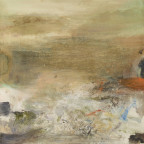Biography
Sam Szafran (b.1934, Paris, France; d.2019, Malakoff, Hauts-de-Seine, France) was a prominent post-war French painter and draughtsman, venerated in France for his precise and psychodramatic pictures painted in a unique and obsessive style that set him apart from mainstream movements. Born as Sami Berger to Polish Jewish immigrants, he escaped the Vel’ d’Hiv’ Roundup in 1942 during the Holocaust but was eventually caught and imprisoned in Drancy while just a child. He was freed by the Americans and emigrated to Australia in 1947 after his father and a large part of his family were killed in the Nazi camps.
In 1951, after several years of exile in Melbourne, Sam Szafran returned to Paris. In 1953, he enrolled in drawing classes at the Académie de la Grande Chaumière. In the early 1950s, Szafran spent his time in the cafés of the Montparnasse quarter, where he met Chet Baker, Jean Arp, Jean-Paul Riopelle, Raymond Mason, Yves Klein, Henri Cartier-Bresson and Jacques Kerchache, who became his first art dealer. He was often destitute and battling a heroin addiction. Meeting Alberto Giacometti became a pivotal experience that greatly influenced Szafran’s work, encouraging him to pursue figuration and focus on a singular motif. Szafran began studying staircases in the 1960s and became obsessed with the staircase at 54, rue de Seine. His Escalier (Stairs) series uses dynamic perspective to convey a dizzying height and whirling motion that recalls the vertigo, fear, and claustrophobia of Hitchcock’s films. The staircase, becoming increasingly abstract as time went on, explores themes of space and perspective depicted in meticulous detail.
In addition to his widely celebrated Escalier series, Szafran is known for his exuberant and dense compositions of the interiors of his studios. They combine studio elements, such as the roof and his drawing materials, with a multitude of plants, particularly philodendrons, which are a central motif in his work. The human figures in Szafran’s paintings, typically women draped in kimonos, are often pushed to the edges of the composition, their presence obscured by the foliage. The focus shifts from the figures themselves to the intricate patterns and textures of the kimonos they wear, which echo the natural forms in the surrounding plants. Szafran most often renders his subjects in pastel, sometimes with watercolour, resulting in a technically precise and obsessive investigation of a narrow range of subjects. Pastel is known for being a notoriously difficult material to use, demanding exactness and a delicate balance of colour and texture, making Szafran’s work even more spectacular.
In 1957, Sam Szafran participated in the Salon des Indépendants in Paris. His first solo exhibition was in 1965 at Galerie Jacques Kerchache in Paris. Retrospectives of his work have been held at Fondation Gianadda, Martigny, Switzerland (1999–2000, 2013, 2023); Fondation Maeght, Saint-Paul-de-Vence (2000); Musée de la Vie Romantique, Paris (2000–2001); and Max Ernst Museum, Brühl, Germany (2010); Musée de l'Orangerie, Paris (2023). Szafran was distinguished with several awards, including the prestigious Commandeur de l'Ordre des Arts et des Lettres in 2013 and the Grand Prix des Arts of the City of Paris in 1993. Szafran’s works are held in major museum collections around the world, including the Metropolitan Museum of Art, New York; Centre Georges Pompidou, Paris; Musée d’Orsay, Paris; Fondation Maeght; and Fondation Gianadda.
继续作品
-
 Sam Szafran, Escalier rue de Seine (Autoportrait), c.1979-1980
pastel and gouache on paper mounted on board
30 x 22 1/2 in
76 x 57 cm
%3Cdiv%20class%3D%22artist%22%3E%3Cspan%20class%3D%22artist%22%3E%3Cstrong%3ESam%20Szafran%3C/strong%3E%3C/span%3E%3C/div%3E%0D%3Cdiv%20class%3D%22title%22%3E%3Cem%3EEscalier%20rue%20de%20Seine%20%28Autoportrait%29%3C/em%3E%2C%20c.1979-1980%3C/div%3E%0D%3Cdiv%20class%3D%22medium%22%3Epastel%20and%20gouache%20on%20paper%20mounted%20on%20board%3C/div%3E%0D%3Cdiv%20class%3D%22dimensions%22%3E30%20x%2022%201/2%20in%3Cbr%20/%3E%0A76%20x%2057%20cm%3C/div%3E
Sam Szafran, Escalier rue de Seine (Autoportrait), c.1979-1980
pastel and gouache on paper mounted on board
30 x 22 1/2 in
76 x 57 cm
%3Cdiv%20class%3D%22artist%22%3E%3Cspan%20class%3D%22artist%22%3E%3Cstrong%3ESam%20Szafran%3C/strong%3E%3C/span%3E%3C/div%3E%0D%3Cdiv%20class%3D%22title%22%3E%3Cem%3EEscalier%20rue%20de%20Seine%20%28Autoportrait%29%3C/em%3E%2C%20c.1979-1980%3C/div%3E%0D%3Cdiv%20class%3D%22medium%22%3Epastel%20and%20gouache%20on%20paper%20mounted%20on%20board%3C/div%3E%0D%3Cdiv%20class%3D%22dimensions%22%3E30%20x%2022%201/2%20in%3Cbr%20/%3E%0A76%20x%2057%20cm%3C/div%3E -
 Sam Szafran, Lilette en Ikat assise sur le banc Gaudi, 2010
watercolour and pastel on silk
47 1/4 x 61 5/8 in
120 x 156.5 cm
%3Cdiv%20class%3D%22artist%22%3E%3Cspan%20class%3D%22artist%22%3E%3Cstrong%3ESam%20Szafran%3C/strong%3E%3C/span%3E%3C/div%3E%0D%3Cdiv%20class%3D%22title%22%3E%3Cem%3ELilette%20en%20Ikat%20assise%20sur%20le%20banc%20Gaudi%3C/em%3E%2C%202010%3C/div%3E%0D%3Cdiv%20class%3D%22medium%22%3Ewatercolour%20and%20pastel%20on%20silk%3Cbr%20/%3E%0A%3C/div%3E%0D%3Cdiv%20class%3D%22dimensions%22%3E47%201/4%20x%2061%205/8%20in%3Cbr%20/%3E%0A120%20x%20156.5%20cm%3C/div%3E
Sam Szafran, Lilette en Ikat assise sur le banc Gaudi, 2010
watercolour and pastel on silk
47 1/4 x 61 5/8 in
120 x 156.5 cm
%3Cdiv%20class%3D%22artist%22%3E%3Cspan%20class%3D%22artist%22%3E%3Cstrong%3ESam%20Szafran%3C/strong%3E%3C/span%3E%3C/div%3E%0D%3Cdiv%20class%3D%22title%22%3E%3Cem%3ELilette%20en%20Ikat%20assise%20sur%20le%20banc%20Gaudi%3C/em%3E%2C%202010%3C/div%3E%0D%3Cdiv%20class%3D%22medium%22%3Ewatercolour%20and%20pastel%20on%20silk%3Cbr%20/%3E%0A%3C/div%3E%0D%3Cdiv%20class%3D%22dimensions%22%3E47%201/4%20x%2061%205/8%20in%3Cbr%20/%3E%0A120%20x%20156.5%20cm%3C/div%3E -
 Sam Szafran, Untitled (Staircase), 1994
watercolour on silk
46 x 35 5/8 in
117 x 90.5 cm
%3Cdiv%20class%3D%22artist%22%3E%3Cspan%20class%3D%22artist%22%3E%3Cstrong%3ESam%20Szafran%3C/strong%3E%3C/span%3E%3C/div%3E%0D%3Cdiv%20class%3D%22title%22%3E%3Cem%3EUntitled%20%28Staircase%29%3C/em%3E%2C%201994%3C/div%3E%0D%3Cdiv%20class%3D%22medium%22%3Ewatercolour%20on%20silk%3Cbr%20/%3E%0A%3C/div%3E%0D%3Cdiv%20class%3D%22dimensions%22%3E46%20x%2035%205/8%20in%3Cbr%20/%3E%0A117%20x%2090.5%20cm%3C/div%3E
Sam Szafran, Untitled (Staircase), 1994
watercolour on silk
46 x 35 5/8 in
117 x 90.5 cm
%3Cdiv%20class%3D%22artist%22%3E%3Cspan%20class%3D%22artist%22%3E%3Cstrong%3ESam%20Szafran%3C/strong%3E%3C/span%3E%3C/div%3E%0D%3Cdiv%20class%3D%22title%22%3E%3Cem%3EUntitled%20%28Staircase%29%3C/em%3E%2C%201994%3C/div%3E%0D%3Cdiv%20class%3D%22medium%22%3Ewatercolour%20on%20silk%3Cbr%20/%3E%0A%3C/div%3E%0D%3Cdiv%20class%3D%22dimensions%22%3E46%20x%2035%205/8%20in%3Cbr%20/%3E%0A117%20x%2090.5%20cm%3C/div%3E -
 Sam Szafran, Feuillages avec personnage (Foliage with figure), 1984
pastel on cardboard
47 x 31 1/2 in
119.2 x 80 x 0.01 cm
%3Cdiv%20class%3D%22artist%22%3E%3Cspan%20class%3D%22artist%22%3E%3Cstrong%3ESam%20Szafran%3C/strong%3E%3C/span%3E%3C/div%3E%0D%3Cdiv%20class%3D%22title%22%3E%3Cem%3EFeuillages%20avec%20personnage%20%28Foliage%20with%20figure%29%3C/em%3E%2C%201984%3C/div%3E%0D%3Cdiv%20class%3D%22medium%22%3Epastel%20on%20cardboard%3C/div%3E%0D%3Cdiv%20class%3D%22dimensions%22%3E47%20x%2031%201/2%20in%3Cbr%20/%3E%0A119.2%20x%2080%20x%200.01%20cm%3C/div%3E
Sam Szafran, Feuillages avec personnage (Foliage with figure), 1984
pastel on cardboard
47 x 31 1/2 in
119.2 x 80 x 0.01 cm
%3Cdiv%20class%3D%22artist%22%3E%3Cspan%20class%3D%22artist%22%3E%3Cstrong%3ESam%20Szafran%3C/strong%3E%3C/span%3E%3C/div%3E%0D%3Cdiv%20class%3D%22title%22%3E%3Cem%3EFeuillages%20avec%20personnage%20%28Foliage%20with%20figure%29%3C/em%3E%2C%201984%3C/div%3E%0D%3Cdiv%20class%3D%22medium%22%3Epastel%20on%20cardboard%3C/div%3E%0D%3Cdiv%20class%3D%22dimensions%22%3E47%20x%2031%201/2%20in%3Cbr%20/%3E%0A119.2%20x%2080%20x%200.01%20cm%3C/div%3E















